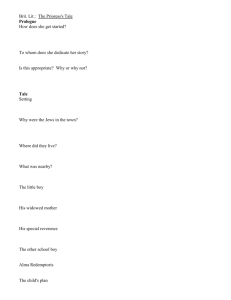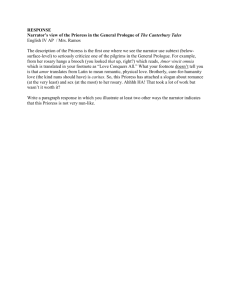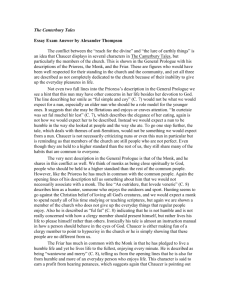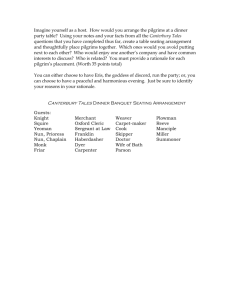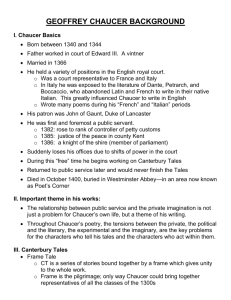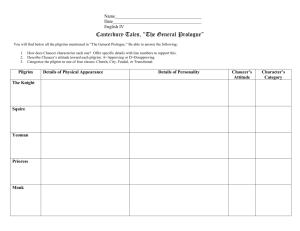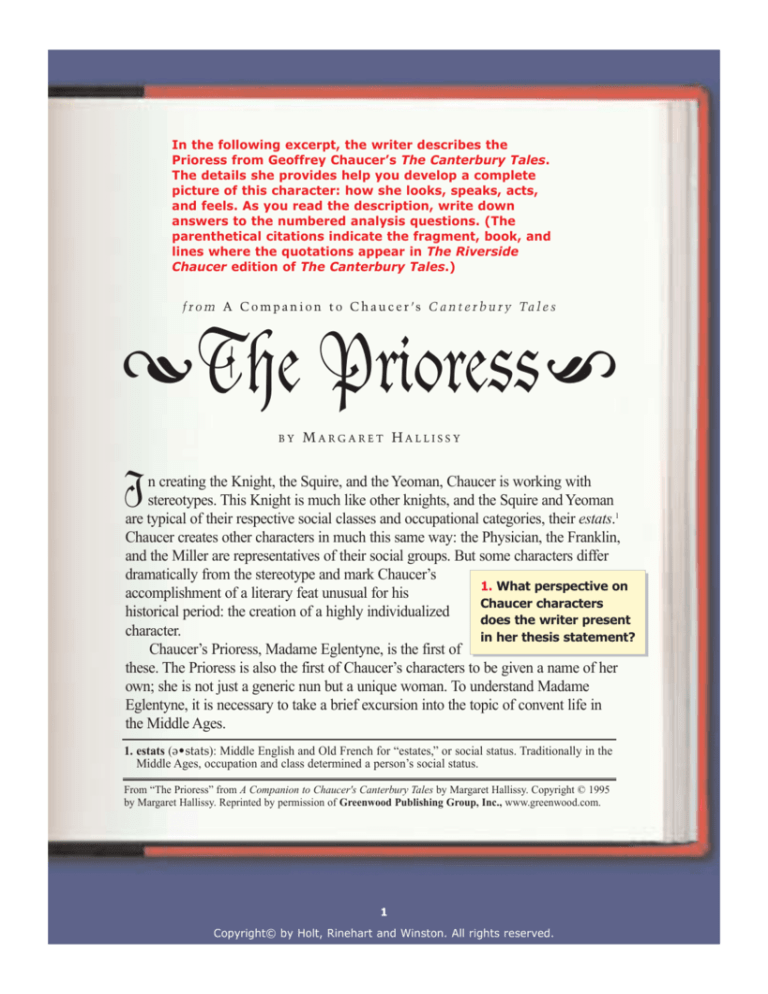
In the following excerpt, the writer describes the
Prioress from Geoffrey Chaucer’s The Canterbury Tales.
The details she provides help you develop a complete
picture of this character: how she looks, speaks, acts,
and feels. As you read the description, write down
answers to the numbered analysis questions. (The
parenthetical citations indicate the fragment, book, and
lines where the quotations appear in The Riverside
Chaucer edition of The Canterbury Tales.)
f r o m A C o m p a n i o n t o C h a u c e r ’ s C a n t e r b u r y Ta l e s
The Prioress BY
MARGARET HALLISSY
I
n creating the Knight, the Squire, and the Yeoman, Chaucer is working with
stereotypes. This Knight is much like other knights, and the Squire and Yeoman
are typical of their respective social classes and occupational categories, their estats.1
Chaucer creates other characters in much this same way: the Physician, the Franklin,
and the Miller are representatives of their social groups. But some characters differ
dramatically from the stereotype and mark Chaucer’s
1. What perspective on
accomplishment of a literary feat unusual for his
Chaucer characters
historical period: the creation of a highly individualized
does the writer present
character.
in her thesis statement?
Chaucer’s Prioress, Madame Eglentyne, is the first of
these. The Prioress is also the first of Chaucer’s characters to be given a name of her
own; she is not just a generic nun but a unique woman. To understand Madame
Eglentyne, it is necessary to take a brief excursion into the topic of convent life in
the Middle Ages.
1. estats (ß•stats): Middle English and Old French for “estates,” or social status. Traditionally in the
Middle Ages, occupation and class determined a person’s social status.
From “The Prioress” from A Companion to Chaucer's Canterbury Tales by Margaret Hallissy. Copyright © 1995
by Margaret Hallissy. Reprinted by permission of Greenwood Publishing Group, Inc., www.greenwood.com.
1
Copyright© by Holt, Rinehart and Winston. All rights reserved.
Medieval women were perceived as having two basic life choices: religious life
or secular life as married women. Since an unmarried woman had no real place in
medieval society, any woman who could not marry, or who chose not to, affiliated
with a religious order. A woman might become a nun for several reasons. She
might be the real thing: a person with a genuine vocation2 to place her relationship
with God above all else. She might be attracted to the ordered, peaceful life of
prayer, work, and study that the convent offered. Women could pray and work in
any estat; but at a time when intellectual opportunities were available only to the
few, the convent provided a level of education that was not available elsewhere to
women. Less in accord with the intended purpose of convent life was the custom of
using it as an alternative of last resort for women who were for any reason
unmarriageable: those whose families could not afford a dowry (money and/or land
settled upon a girl at marriage); or those who were simply too unattractive to snare
a mate. Since Chaucer’s Prioress is specifically
described as attractive, she may have been consigned 3 to 2. What background
information does the
a convent for reasons of family convenience, because it
writer give about
is clear that she lacks a true religious calling. In Madame
convent life in the
Eglentyne, Chaucer depicts charm without substance.
Middle Ages? How does
Although the Prioress is appealing, she represents the
the Prioress’s physical
decline of convent life in the Middle Ages, from a haven appearance relate to
for saints and scholars to a finishing school for proper,
this information?
but vapid,4 ladies.
The Prioress is exceedingly well-mannered. She smiles sweetly and demurely,
and uses only the mildest oath. She knows how to chant the liturgy, intoning it
through her nose in a seemly manner. She can speak French, a genteel
accomplishment then as now, but only as it is taught in England, not as it is spoken
in Paris; in other words, there is a superficiality even to such limited learning as she
has. Many behavior manuals available in the fourteenth century stressed proper
behavior at table, and the Prioress has learned these social graces. She doesn’t drop
bits of food on the way to her mouth, nor does she allow bits of food to fall onto
her breast; she does not “wet her fingers in the deep [bowls of] sauce” (1, A, 129)
when she dips a bit of food into them, she wipes her upper lip clean of grease
2. vocation (vó•ká’Çßn): a calling.
3. consigned (kßn•sínd’): handed over.
4. vapid (vap’id): dull, shallow, boring.
2
Copyright© by Holt, Rinehart and Winston. All rights reserved.
before she drinks from her wine glass; she reaches for her
3. What details does the
food politely rather than grabbing for it in a rude, lowerwriter provide about the
class manner. All this detail shows that she was “well
Prioress’s manners?
taught” (1, A, 127) on how to behave in company. But
What do these social
what has this to do with the religious life? The fact that
graces suggest about
the Prioress knows such “courtesy” (1, A, 132) suggests
the Prioress’s character?
that she is attracted more to fashionable society than to
the convent.
Other details of Madame Eglentyne’s portrait show that in conducting herself
as a courtly lady she is implicitly violating the spirit of her religious commitment.
“Great deportment,” a pleasant, “amiable,” “stately . . . manner” (1, A, 137–140),
are all qualities more suitable to the courtly lady than to the nun. A nun is not
supposed to “counterfeit the manners/Of court” or worry if she is being “held
worthy of reverence” in society (1, A, 139–141). The cumulative effects of all these
details would indicate to the medieval reader that the Prioress’s values were secular,
not religious; and the point would be reinforced by her behavior with animals.
In the medieval convent, pets were either strongly discouraged or downright
forbidden. Since the nun was supposed to direct her love toward God alone, a pet
would be a distraction, a worldly affection that the nun should reject. But the
Prioress is emotionally overinvolved with animals, particularly small, cute ones:
She was so charitable and so full of pity
That she would weep, if she saw a mouse
Caught in a trap, if it were dead or bled.
(1, A, 143–145)
4. How does this long
quotation support the
writer’s claim that the
Prioress’s feelings
toward animals are
excessive?
This behavior often appeals to animal lovers in Chaucer’s modern audience, but “charity” for the medieval nun is supposed to mean love
directed upward toward God, not directed downward toward what medieval people
regard as lower beings.
Even worse than weeping for a mouse is the Prioress’s 5. What actions of the
Prioress does the writer
behavior with her dogs. Some medieval religious orders
describe in this parallowed cats; but dogs were never allowed. Despite this
agraph? Why are these
prohibition,
actions at odds with her
vocation as a nun?
3
Copyright© by Holt, Rinehart and Winston. All rights reserved.
She had small hounds that she fed
With roasted flesh, or milk and white bread,
And she wept bitterly if one of them were dead.
(1, A, 146–148)
Little lapdogs were popular accessories of the flirtatious courtly lady; she
could cuddle cutely with them, thus displaying her “tender heart” (1, A, 150) and
in general looking utterly adorable. Such behavior would be silly and trivial even
in a marriageable young girl, and it is entirely inappropriate for a nun. The
Prioress’s feeding the small hounds with roast meat and white bread—both
culinary treats in the Middle Ages—shows that her convent is extravagant
(religious rules prescribed humble fare) and that leftovers are not being given to
the poor. The Prioress weeps for dead pets, but she should be weeping for the
sorry state of her own spiritual development. Her “conscience” (1, A, 150) is
misinformed about the proper object of her tender-hearted solicitude.
Her sense of appropriateness is also defective in the matter of her array.5 Nuns
were supposed to be indifferent to their appearance and unconcerned with
clothing. The habits or uniform apparel adopted by religious orders (the wearing
of which was abandoned only in the mid-twentieth century) were based on the
garb of widows. Simple, modest, and inexpensive, the nun’s habit was supposed to
contrast with the lavish array of wealthy women in secular life. Thus the Prioress
violates the spirit of religious life by wearing an attractively pleated wimple or
head-dress, an elegant cloak, and an expensive set of coral prayer beads. Most
questionable of all is her brooch. If lavish and costly clothing was forbidden to a
nun, all the more was jewelry. Worse, this gold brooch
6. What details about
contains an inscription: “Amor vincit omnia,” love
the Prioress’s clothing
conquers all (1, A, 162). What kind of love is suggested
does the writer
by this brooch? The love of God or the love of a man?
provide? Why do you
Chaucer leaves the matter tantalizingly unresolved. But in think she discusses the
presenting a character who conforms to the stereotype of
brooch last?
the courtly lady, with her small nose, her grey eyes, her
small, soft, red mouth, Chaucer calls our attention to the moral ambiguity
surrounding a person whose appearance and behavior fit her more for secular life
than for religious life.
5. array (ß•rá’): fine clothing.
4
Copyright© by Holt, Rinehart and Winston. All rights reserved.


